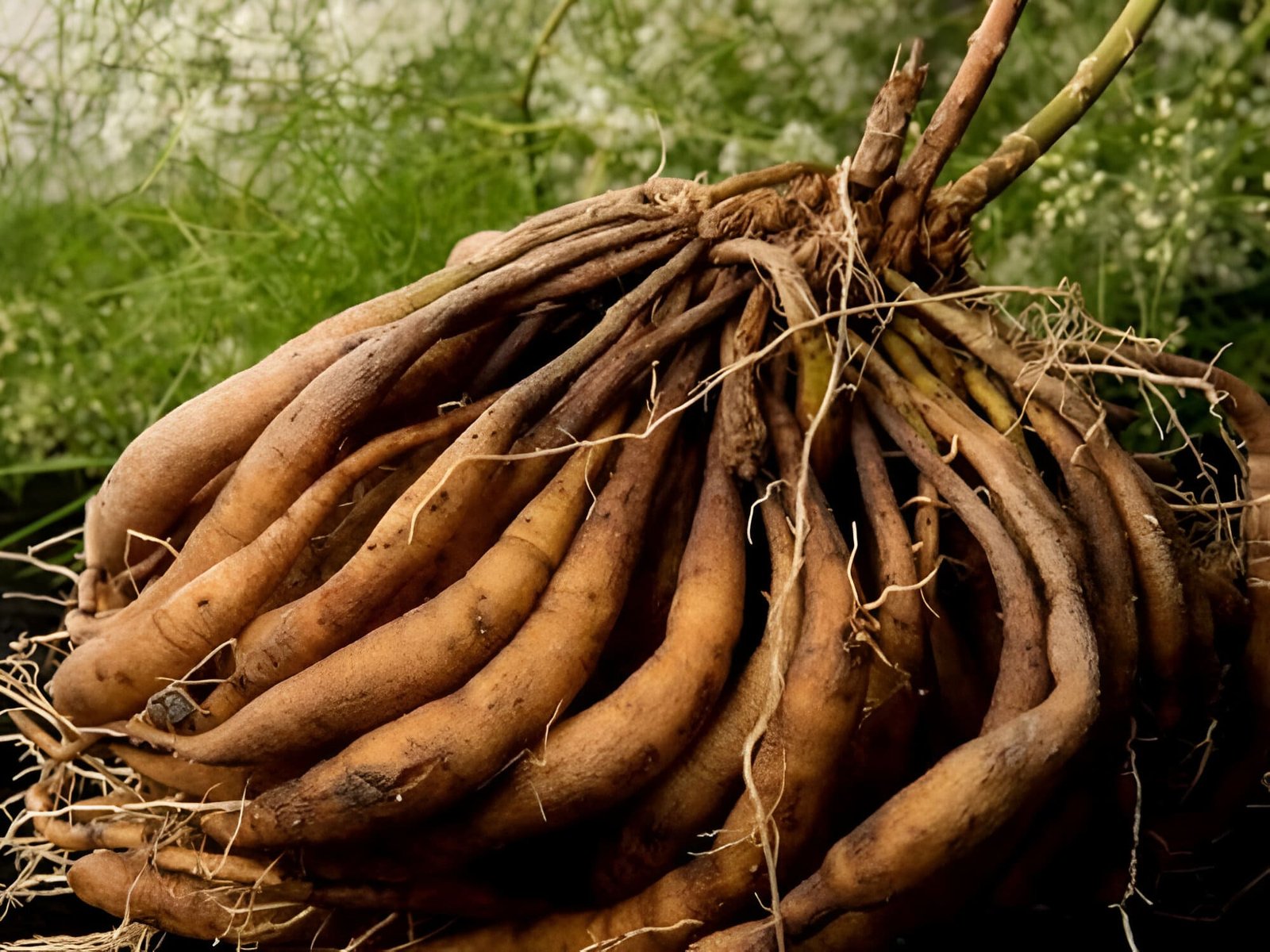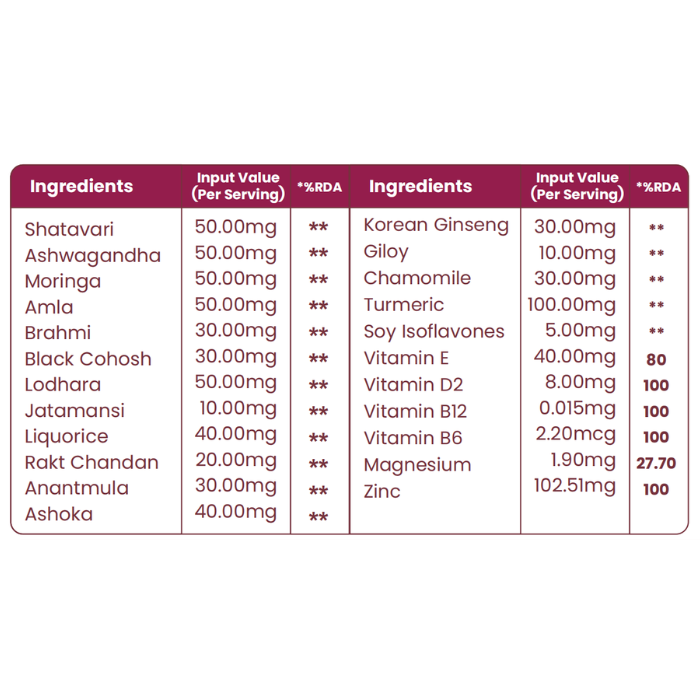Don't miss our holiday offer - up to 10% OFF!
Shatavari for Perimenopause: How Shatavari Supports Hormones During Perimenopause

Introduction
Perimenopause represents a profound time of transition in a woman’s life. It marks the years leading up to menopause when hormone levels begin to fluctuate, cycles become unpredictable, and symptoms such as hot flashes, mood swings, and sleep disturbances emerge.
While modern medicine offers various therapies, many women seek holistic, gentle, and natural solutions. Among the most respected botanicals in Ayurvedic medicine is Shatavari (Asparagus racemosus), often called the “Queen of Herbs” for female wellness.
This guide explores how Shatavari can support and nurture the female body and mind during perimenopause.
What Is Perimenopause?
Perimenopause refers to the years of hormonal flux, usually starting in a woman’s 40s, but sometimes as early as the mid-30s. Changes are driven by irregular ovarian function, causing unpredictable shifts in hormone levels especially estrogen and progesterone. Common symptoms include:
- Irregular periods (shorter, longer, heavier, or lighter)
- Hot flashes and night sweats
- Anxiety and mood swings
- Sleep disturbances
- Fatigue
- Vaginal dryness
- Changes in libido
- Cognitive shifts (“brain fog”)
Symptoms result from not just estrogen decline, but also from wide fluctuations—sometimes surges—of hormones.
Shatavari in Ayurveda and Traditional Medicine
Shatavari has been revered in Ayurveda as a “female rejuvenator” and hormone balancer. Traditionally, it is used to:
- Nourish the reproductive system
- Soothe digestive complaints
- Support lactation and fertility
- Calm the nervous system and adapt to stress
The Sanskrit name means “one who possesses a hundred husbands,” referencing its broad support for female hormonal and reproductive health.
Unique Properties of Shatavari Relevant to Perimenopause
1. Rich Source of Natural Phytoestrogens
Shatavari contains steroidal saponins (shatavarins) that act as phytoestrogens. These plant-based compounds bind to estrogen receptors and can both:
- Provide a mild estrogenic effect when the body’s hormone levels are low (e.g., late perimenopause)
- Buffer against estrogen dominance by competing with stronger human estrogens during surges
This dual effect means Shatavari helps stabilize wild estrogen swings rather than forcing a single direction on hormone levels.
2. Adaptogen: Easing Stress and Supporting the HPA Axis
Perimenopausal symptoms are influenced by stress and cortisol levels, as the body adapts to changing ovarian output. The adrenal glands take on a backup role producing estrogen precursors. Shatavari is a potent adaptogen, meaning it helps regulate the hypothalamic-pituitary-adrenal (HPA) axis, increasing stress resilience and supporting adrenal function during this hormonal transition.
- Reduces feelings of overwhelm, anxiety, and emotional volatility
- Enhances energy, stamina, and overall stress adaptation
3. Support for the Reproductive and Menstrual Systems
With cycle irregularity a hallmark of perimenopause, Shatavari offers:
- Uterine tonic effects—strengthening and regulating uterine function
- Balancing action on Vata and Pitta (in Ayurveda), which are often aggravated during hormonal transitions
- Reduced menstrual discomfort such as cramps and heavy bleeding
4. Relief of Core Perimenopausal Symptoms
Hot Flashes and Night Sweats
Shatavari’s cooling nature and phytoestrogens help curb vasomotor symptoms like hot flashes and night sweats by modulating estrogenic activity and calming the body.
Mood Swings and Emotional Shifts
By supporting hormonal stability and calming the mind, Shatavari helps alleviate mood swings, irritability, and increased anxiety—common complaints in perimenopause.
Vaginal Dryness and Libido
As estrogen drops, vaginal tissue can become dry, thin, and more prone to discomfort. Shatavari’s estrogen-modulating and lubricating qualities support vaginal health, reduce dryness, and may naturally enhance libido.
Sleep Disturbances
Hormonal upheaval is often disruptive to sleep. Shatavari’s adaptogenic effect calms the nervous system, lessening anxiety and restlessness, thereby supporting more restful sleep.
Scientific Evidence Supporting Shatavari for Perimenopause
Human Clinical Studies
Recent research on Shatavari has found:
- Twice-daily doses of Shatavari extract for 60 days led to significant improvements in menopausal symptoms such as hot flashes, sleep disturbances, anxiety, and mood, with good tolerability and safety profile8.
- Shatavari’s active compounds can normalize estrogenic activity, potentially reducing both excesses and lows of estrogen by modulating hormone receptor activity in the body3.
- It influences neurotransmitter balance, providing an anxiolytic (calming) effect and supporting the nervous system against stressors heightened by hormonal fluctuations5.
Mechanisms of Action
- Steroidal saponins interact with estrogen receptors to gently support feminine hormone balance43.
- Rutin, another constituent, can bind to estrogen receptors and contribute to hormonal equilibrium3.
- Antioxidant and anti-inflammatory properties may protect tissues against oxidative stress and inflammation, common during perimenopausal changes91.
Additional Benefits of Shatavari During Perimenopause
Bone and Cardiovascular Health
The decline and erratic nature of estrogen in perimenopause herald significant risk for bone loss and cardiovascular disease. Shatavari has shown:
- Estrogen-like effects that may help preserve bone mineral density and promote healthy bones as the body transitions to menopause.
- Antioxidant effects supporting vascular health, potentially improving heart health during and after perimenopause.
Immune System, Digestion, and General Longevity
- Shatavari’s adaptogenic profile strengthens the immune system, a boon when stress and aging begin to impact defenses4.
- It soothes digestion, alleviates bloating, and aids nutrient assimilation—common digestive complaints for many women in their 40s and 50s.
How to Take Shatavari for Perimenopausal Support
Typical forms:
- Powders (traditionally mixed with warm milk or honey)
- Capsules
- Liquid extracts
Suggested dose (general guidance only):
- Powder: 1/4 to 1/2 teaspoon, 1-2 times per day
- Capsules: Per product instructions (commonly 250mg twice daily)
Consistency is key herbal benefits accrue over several weeks of regular use. Always consult with a qualified healthcare provider before adding new supplements, especially if you are on medication or have underlying health issues.
Potential Side Effects and Safety
Shatavari has a strong safety record in human studies, with very few adverse effects reported8. However:
- Those with asparagus or related allergies should avoid it
- People with estrogen-sensitive conditions (e.g., certain breast or uterine cancers) should consult their doctor before use
- It may have mild diuretic effects in some users
Always purchase from reputable suppliers to avoid contamination.
Integrating Shatavari into a Perimenopausal Lifestyle
Shatavari is not a “quick-fix” but rather a gentle, holistic aid. For optimal support, combine it with:
- A balanced, whole-foods diet rich in phytoestrogens (such as flaxseed, soy, sesame)
- Regular physical activity, including bone-strengthening exercises
- Stress-reduction practices: yoga, meditation, mindful breathing
- Good sleep hygiene
- Social support, therapy, or support groups
Frequently Asked Questions about Shatavari and Perimenopause
Can Shatavari replace hormone replacement therapy (HRT)?
Shatavari may help mild-to-moderate symptoms and support overall wellness, but it is not a substitute for medical interventions in cases of severe symptoms or specific conditions that require HRT. Always discuss options with your doctor.
When should I start taking Shatavari?
It may be started when early signs of perimenopause become noticeable—irregular cycles, mood changes, or gentle vasomotor symptoms. Early-to-mid perimenopause is ideal, but benefits may still be seen even as menopause approaches.
How long should I take Shatavari?
Most benefits are seen after 8–12 weeks. For ongoing symptom relief, daily use can be maintained (with breaks if necessary) unless advised otherwise by your healthcare provider.
Conclusion
Shatavari stands out as a botanical ally for women navigating the often unpredictable and sometimes tumultuous years of perimenopause. Its unique blend of phytoestrogenic, adaptogenic, and nourishing properties make it an ideal herbal supplement for managing hot flashes, mood swings, cycle irregularity, and emotional fluctuations.
Backed by both ancient wisdom and growing scientific validation, Shatavari has rightfully earned its reputation as the “Queen of Herbs” for women seeking natural balance, calm, and vigor during perimenopause and beyond.
As with all natural therapies, the journey with Shatavari is individual. Approach your health with curiosity, gentleness, and the wisdom of both traditional and modern knowledge. Always seek personalized guidance when embarking on a new wellness regimen.











